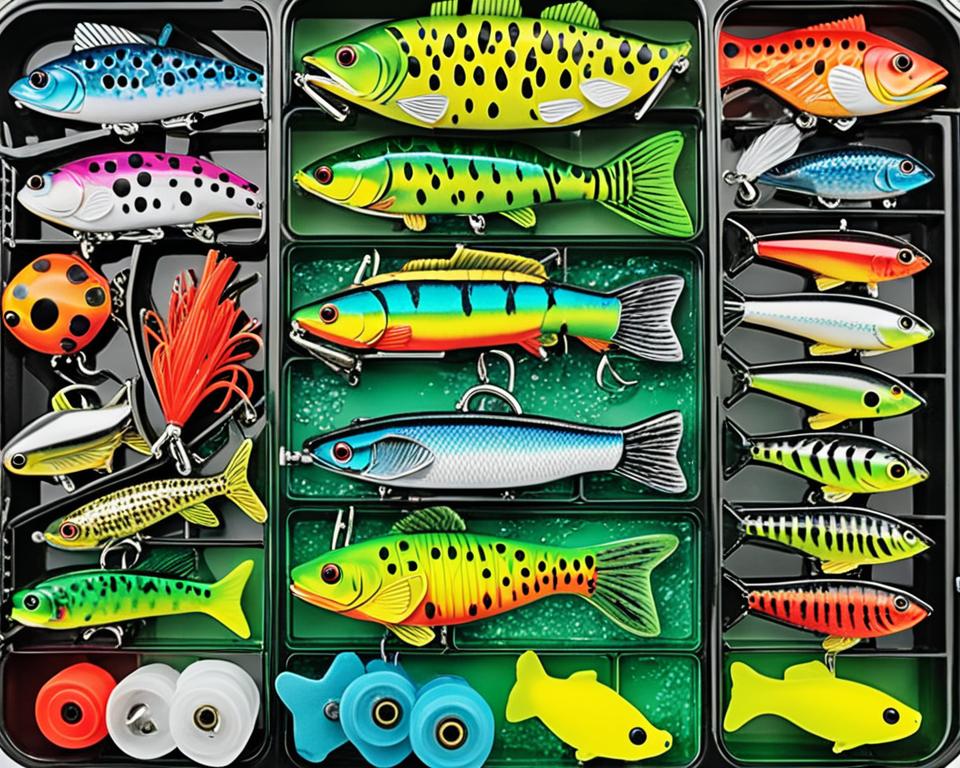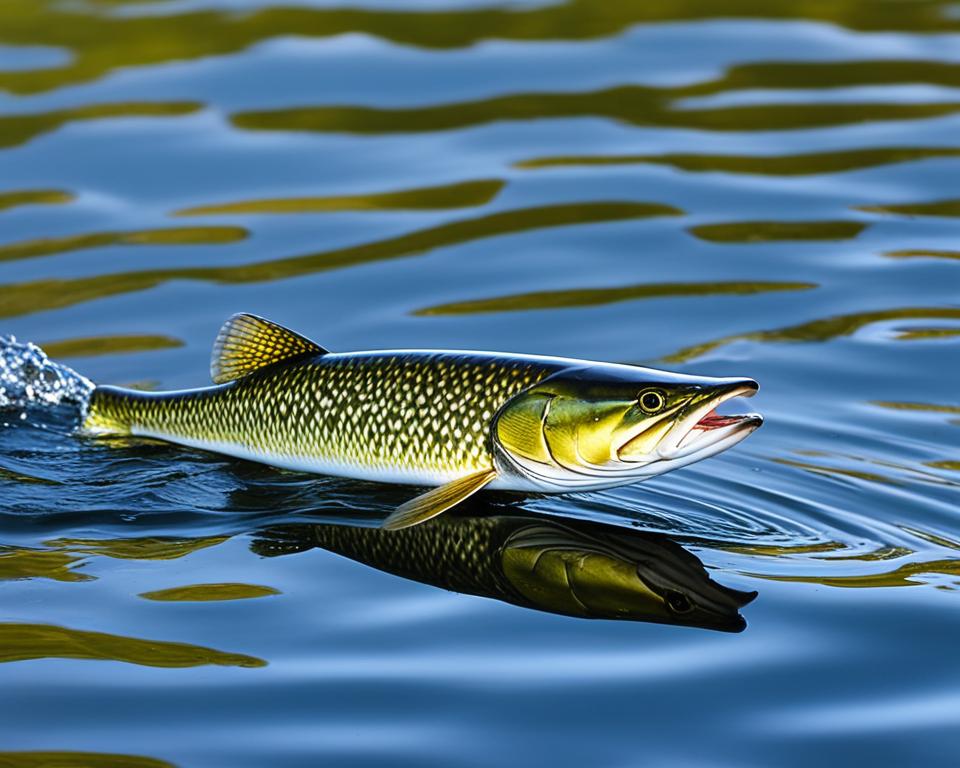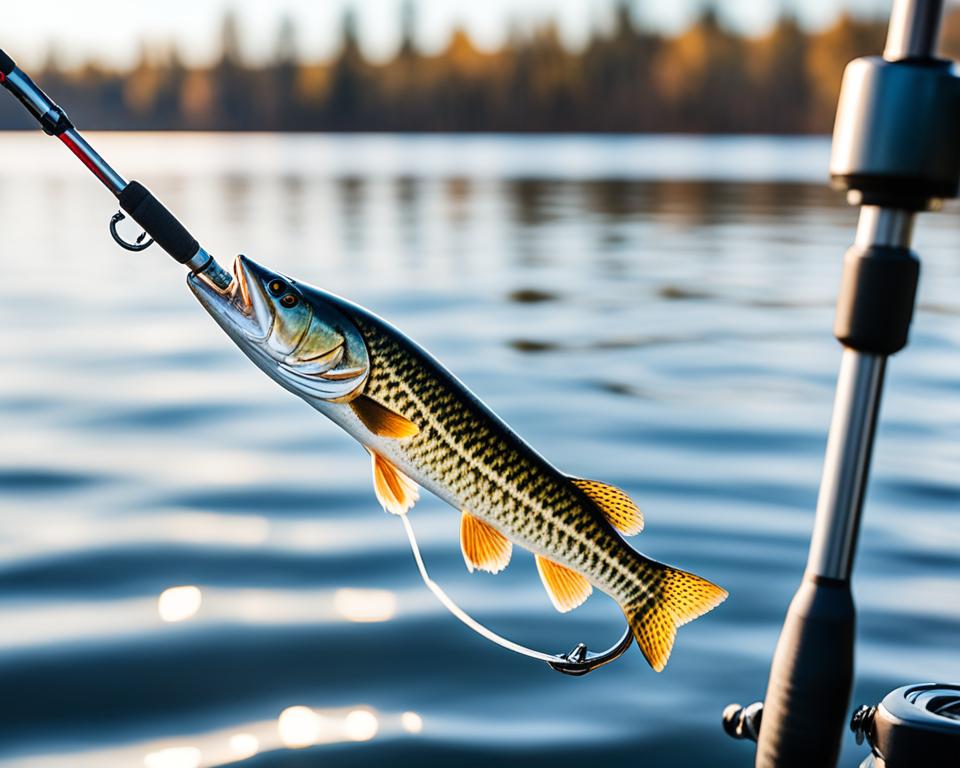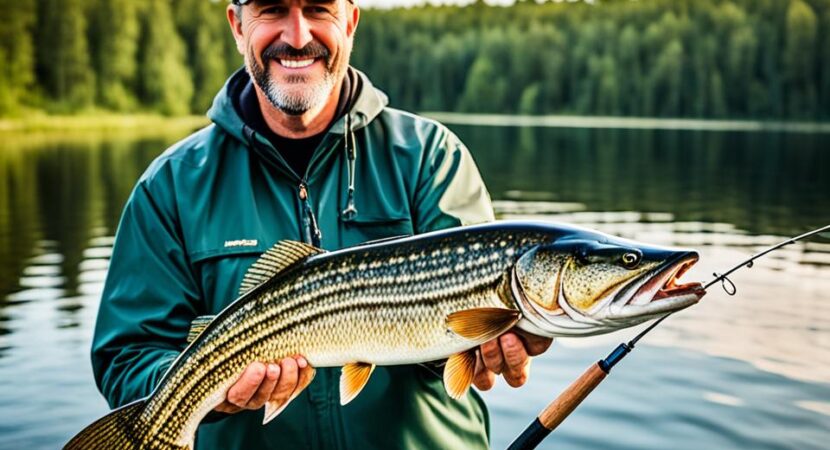Northern pike, often referred to as the freshwater shark, is one fish every angler should pursue at one point in their life. This voracious predator is known for its sharp teeth, large mouth, and insatiable appetite. Pike can grow to impressive sizes that seem almost unbelievable compared to other freshwater fish. If you’re looking to catch northern pike, you’re in luck – nearly all states in the northern tier of the country have lakes where you can find them.
In New England, Vermont boasts the best pike fishing in the region. New York, with its Great Lakes border, is another excellent destination for pike anglers, as are Michigan, Minnesota, and Wisconsin. The Dakotas and Colorado offer good pike fishing opportunities in reservoirs, while Alaska is known for its exceptional pike fisheries. For those seeking the biggest pike and the least fishing pressure, the wilderness waters of the Canadian provinces are hard to beat.
Whether you’re a seasoned angler or just starting out, this friendly guide will provide you with valuable tips and techniques for catching northern pike. From choosing the right gear to mastering lure presentation and seasonal strategies, we’ll cover everything you need to know to successfully target these thrilling game fish.
Contents
Key Takeaways
- Northern pike are known for their sharp teeth, large mouths, and aggressive appetites
- Pike can be found in many northern states, with Vermont, New York, Michigan, Minnesota, and Wisconsin being top destinations
- The wilderness waters of the Canadian provinces offer the biggest pike and the least fishing pressure
- Choosing the right gear, mastering lure presentation, and understanding seasonal patterns are key to catching northern pike
- This guide will provide valuable tips and techniques for anglers of all skill levels looking to target northern pike
Gearing Up for Northern Pike Fishing
To embark on a successful northern pike fishing adventure, it’s essential to equip yourself with the right gear. From selecting the appropriate rod and reel to choosing the best line and leader, every component plays a crucial role in landing these formidable predators. Let’s dive into the key elements of northern pike fishing equipment that will help you tackle even the most challenging catches.
Choosing the Right Rod and Reel
When targeting wilderness northerns weighing 10 to 20 pounds or more, opt for spinning outfits that can handle 14- to 20-pound-test line or medium-heavy baitcasting outfits in 17- to 20-pound test. For smaller pike in the 5- to 10-pound range, your trusty bass tackle will suffice. Consider using 6- to 10-pound-test spinning gear or light to medium baitcasting outfits spooled with 12- to 14-pound-test line. Investing in quality pike fishing rods and reels ensures you have the necessary backbone and durability to battle these hard-fighting fish.
Line and Leader Selection
Your choice of line and leader is crucial when it comes to pike fishing equipment. While some anglers prefer heavy monofilament leaders in the 30-pound range, steel leaders are the go-to option for securely attaching hooks. Pike’s razor-sharp teeth can easily slice through regular fishing line, so opting for a robust leader material is essential to prevent heartbreaking break-offs. Consider the following table for selecting the appropriate line and leader based on the size of pike you’re targeting:
| Pike Size | Main Line | Leader Material | Leader Strength |
|---|---|---|---|
| 5-10 lbs | 12-14 lb test | Fluorocarbon | 30-40 lb test |
| 10-20 lbs | 17-20 lb test | Steel | 30-50 lb test |
| 20+ lbs | 20-30 lb test | Steel | 50-80 lb test |
Essential Accessories: Nets, Pliers, and More
In addition to your northern pike fishing gear, several accessories can make your fishing experience more enjoyable and efficient. A suitable net is a must-have item. There’s nothing more frustrating than getting a pike to the boat or shore only to realize your net is too small. Aim for a net with a hoop size ranging from 20 to 36 inches to accommodate the impressive girth of these fish.
Removing hooks from a pike’s mouth is an art in itself. Equipping yourself with a pair of long needle-nose pliers, a jaw spreader, and a fish lip gripper is highly recommended, especially when dealing with larger specimens. These tools not only facilitate safe hook removal but also minimize stress on the fish during the release process.
Remember, investing in quality northern pike fishing equipment not only enhances your chances of success but also ensures a more enjoyable and memorable fishing experience. With the right gear in hand, you’ll be well-prepared to take on the challenge of catching these magnificent predators.
Top Lures for Catching Northern Pike
When it comes to targeting northern pike, having the right lures in your tackle box can make all the difference. Three proven lure types that consistently produce results are spoons, soft plastic swimbaits, and inline spinners. Each of these lures has unique characteristics that appeal to the predatory instincts of pike, making them essential tools for any angler seeking to land these impressive fish.
Spoons: Versatile and Effective
Spoons are a classic choice among pike fishing lures, and for good reason. Their flashy appearance and erratic action mimic the movements of injured baitfish, making them irresistible to hungry pike. When selecting spoons for your tackle box, focus on sizes ranging from 1/4 to 1 ounce in colors like gold, silver, white, yellow, and chartreuse. These colors often resemble the belly of a struggling prey fish, triggering aggressive strikes from nearby pike.
When casting spoons, allow them to flutter and fall during the retrieve. This technique imitates the behavior of a wounded baitfish, grabbing the attention of any pike in the vicinity. Experiment with different retrieval speeds and pauses to find the presentation that works best in your specific fishing scenario.

Soft Plastic Swimbaits: Mimicking Natural Prey
Soft plastic swimbaits have become increasingly popular among pike anglers due to their versatility and ability to mimic a wide range of natural prey. These lures come in various sizes, from small minnow imitations to larger profiles resembling stocker fish. The key to success with swimbaits is to choose a size and color pattern that closely matches the local forage base in your fishing area.
When fishing with swimbaits, experiment with different retrieval techniques to find what triggers strikes from pike. Steady retrieves, erratic twitches, and occasional pauses can all be effective, depending on the mood of the fish and the conditions at hand. Don’t be afraid to customize your swimbaits by adding scent or modifying the tail to create a unique presentation that stands out from the crowd.
Inline Spinners: Creating Irresistible Vibrations
Inline spinners are another top choice for pike anglers, thanks to their ability to create strong vibrations that attract fish from a distance. The blade is the most crucial component of an inline spinner, as it generates the vibrations that pike detect through their sensitive lateral line. When choosing an inline spinner, pay close attention to the size and shape of the blade, as this will determine the strength and frequency of the vibrations produced.
To effectively fish inline spinners for pike, vary your retrieval speed to find the optimal vibration pattern. Slow, steady retrieves can be effective in cold water or when pike are less active, while faster retrieves often trigger strikes from aggressive fish in warmer conditions. Don’t forget to add occasional pauses or twitches to your retrieve, as these can provoke reaction strikes from following pike.
| Lure Type | Key Features | Best Colors | Retrieval Techniques |
|---|---|---|---|
| Spoons | Flashy appearance, erratic action | Gold, silver, white, yellow, chartreuse | Flutter and fall, varying speeds |
| Soft Plastic Swimbaits | Versatile, mimics natural prey | Match local forage | Steady retrieves, twitches, pauses |
| Inline Spinners | Strong vibrations, attracts from a distance | Varied, based on blade type | Slow to fast retrieves, pauses, twitches |
By incorporating these proven northern pike lures into your arsenal and mastering the appropriate retrieval techniques, you’ll be well on your way to consistently catching these impressive predators. Remember to experiment with different colors, sizes, and presentations to find the perfect combination for your specific fishing situation, and don’t be afraid to think outside the box when customizing your lures to stand out from the crowd.
Locating Northern Pike Hotspots
To consistently catch northern pike, it’s crucial to understand their preferred habitats and how to locate these prime fishing spots. By focusing your efforts on areas where pike are most likely to congregate, you can significantly increase your chances of success on the water.
Identifying Ideal Habitats
When searching for northern pike fishing spots, look for inlets, bays, coves, and drop-offs. These areas often feature shallow, marshy sections with an abundance of aquatic vegetation, which pike use for cover and ambush points. Keep an eye out for shoreline structures such as submerged logs and undercut banks, as these spots typically hold large concentrations of baitfish that attract hungry pike.
During the ice-out period, focus on secondary coves that warm up more quickly than the main bay. Pike may have already spawned in the marshy shallows or flooded timber along the edges of these areas. As spring progresses and the sun warms the bay, pike will orient themselves to weed cover near drop-offs, with weedy points and mid-bay weed shoals being particularly productive locations.
- Inlets and bays with shallow, weedy areas
- Coves and drop-offs adjacent to marshy sections
- Shoreline structures (beaver dams, flooded timber, downed trees)
- Secondary coves during ice-out
- Weed cover near drop-offs, points, and mid-bay shoals
Using Maps and Fish Finders
To further refine your search for prime northern pike fishing spots, take advantage of aerial maps and depth charts. These resources allow you to pre-scout potential locations, identifying areas with the right combination of depth, structure, and vegetation. Marking these spots on your map will help you plan efficient fishing trips and cover water effectively.
Once on the water, a quality fish finder becomes an invaluable tool for locating pike. Use your fish finder to scan the bottom contours, identifying drop-offs, weed edges, and submerged structures where pike are likely to hold. Pay attention to any baitfish schools or individual large marks that could indicate the presence of northern pike.
“The key to consistently finding northern pike is to think like they do. Locate the prime habitats where baitfish congregate, and you’ll find the pike close behind, ready to ambush their next meal.”
– Professional Angler Mark Davis
| Habitat Feature | Significance for Northern Pike |
|---|---|
| Shallow, weedy bays | Provides cover and ambush points for pike |
| Drop-offs near weed edges | Allows pike to quickly move between shallow and deep water |
| Submerged structures (logs, stumps) | Attracts baitfish and provides additional ambush points |
| Secondary coves (ice-out) | Warms up quickly, attracting post-spawn pike |
By focusing your efforts on these prime northern pike habitats and utilizing maps and electronics to refine your search, you’ll be well on your way to consistently locating and catching these impressive predators. Remember, find the baitfish, and the pike won’t be far behind.
Mastering Lure Presentation Techniques
When targeting northern pike, mastering your lure presentation is key to successful catches. Whether you’re fishing in weedy areas, around submerged logs, or along drop-offs, adjusting your technique to match the environment is essential for enticing these predatory fish.
For weeded areas, opt for a weedless spoon or a soft plastic swimbait equipped with a weed guard. Cast your line beyond the weedline and slowly retrieve it along the edge of the weeds. Pike often lurk motionlessly among the vegetation, waiting to ambush their prey, so a natural presentation is crucial.

When fishing around submerged logs and undercut banks, an inline spinner can be your go-to lure. These areas often hold concentrations of baitfish, making them prime hunting grounds for pike. Cover a significant amount of water by casting in a fan-style pattern, ensuring thorough coverage of the entire area.
Drop-offs are another prime location for targeting pike, and soft plastic swimbaits can be particularly effective in these areas. If you spot a pike following your lure, maintain a consistent retrieval speed without stopping. Pausing or slowing down may cause the pike to lose interest and swim away.
“The key to successfully retrieving lures for pike is to experiment with different techniques and find what works best in each situation. Vary your retrieval speed, incorporate pauses, and pay attention to how the fish respond.”
Here are some additional tips for mastering your northern pike lure presentation:
- Match your lure size to the size of the local baitfish
- Experiment with different lure colors to find what triggers strikes
- Use a quick, sharp hook set when you feel a bite
- Be prepared for explosive strikes and powerful runs
| Lure Type | Ideal Fishing Situation | Retrieval Technique |
|---|---|---|
| Weedless Spoon | Weedy areas | Slow retrieval along weed edges |
| Soft Plastic Swimbait | Weedy areas, drop-offs | Steady retrieval, match local baitfish |
| Inline Spinner | Submerged logs, undercut banks | Fan-style casting, varied retrieval speed |
By mastering these lure presentation techniques and adapting to different fishing situations, you’ll be well on your way to consistently hooking into impressive northern pike. Remember, patience, persistence, and a willingness to experiment are essential for success when learning how to fish pike lures effectively.
Setting the Hook and Fighting Northern Pike
When it comes to northern pike fishing, the excitement truly begins once you feel that exhilarating tug on your line. Knowing how to properly set the hook and handle the ensuing battle is crucial for landing these powerful predators. Here are some tips to help you master the art of setting the hook and fighting big northern pike.
Proper Hook Setting Technique
As soon as you feel a solid strike, it’s time to set the hook with confidence. Reel in any slack line and give your rod a swift, upward motion to drive the hook point into the pike’s bony mouth. Remember, northern pike have tough jaws, so a firm hook set is essential. If you suspect the fish has gotten off immediately after the strike, don’t give up. Pike are known to play with their prey, so continue retrieving your lure for a potential second chance at a hook set.

Tips for Landing Large Pike
Once you’ve successfully set the hook, get ready for an adrenaline-pumping battle. Northern pike are renowned for their powerful runs and aggressive fighting style. Their flat, elongated bodies allow them to make lightning-fast bursts away from anglers, often leading to intense struggles and potential cut lines. When fighting big northern pike, keep these tips in mind:
- Maintain a tight line to prevent the fish from throwing the hook
- Use a medium to heavy action rod with a sturdy backbone to withstand powerful runs
- Be prepared for extended fights, especially when targeting trophy-sized pike
- Have a large landing net or cradle ready to safely secure your catch
In some waters, northern pike can reach impressive sizes, with specimens exceeding 10, 20, or even 40 pounds. On rare occasions, anglers have reported landing pike surpassing the 50-pound mark! When battling these behemoths, patience, skill, and the right gear are essential for emerging victorious.
After landing your pike, always exercise caution when removing the hook. Pike possess razor-sharp teeth designed to grip and shred their prey, including other fish and even small mammals. To avoid injury, use long-nose pliers or a hook removal tool to safely extract the hook from the pike’s mouth.
“The key to successfully landing big northern pike is to stay calm, trust your gear, and enjoy the thrill of the fight. With practice and persistence, you’ll soon be holding up your own trophy catch for that unforgettable photograph.”
How to Catch Northern Pike: Seasonal Strategies
When it comes to catching northern pike, timing is everything. Understanding the best time to target these fierce predators can significantly improve your chances of success. Let’s explore the optimal seasonal strategies for pike fishing.
Spring Pike Fishing Tactics
May is undoubtedly the prime time for pike fishing in the northern United States and southern Canada. Having recuperated from spawning, pike actively hunt for panfish and baitfish in the shallows. With minimal weed growth, there are fewer ambush spots for these northerns. They also haven’t encountered lures in months, making spring pike fishing as good as it gets.
During the spring months, focus your efforts on shallow sloughs and backwaters sheltered from currents. These areas provide ideal conditions for pike to thrive and feed actively.

Summer and Fall Approaches
While spring may be the peak season, summer and fall offer unique opportunities for catching northern pike. As temperatures begin to cool off in the fall, pike become more aggressive in their pursuit of calories before winter. This period can produce some of the most exciting topwater action.
When targeting pike during the summer and fall months, consider the following approaches:
- Focus on weed edges and drop-offs where pike tend to ambush prey
- Experiment with larger lures that mimic the size of available forage fish
- Fish during low-light periods, such as early mornings or late evenings, when pike are most active
Ice Fishing for Northern Pike
As winter arrives and ice forms on the lakes, pike become less active and tend to suspend in the water column, moving slowly. To entice these cold-water predators, employ tactics specifically tailored for ice fishing.
“When it comes to ice fishing for pike, patience and persistence are key. Slow down your presentation and use lures that can be suspended at various depths to trigger strikes from lethargic fish.” – Experienced Ice Angler
When the water is colder, shallow sloughs that receive ample sunlight can be productive spots. Pike may congregate in these areas to absorb warmth and conserve energy. Utilize fish finders, jigs, and suspended baits to locate and tempt these winter warriors.
| Season | Best Time | Key Tactics |
|---|---|---|
| Spring | May | Fish shallow sloughs and backwaters |
| Summer | Early morning and late evening | Target weed edges and drop-offs |
| Fall | Cooling water temperatures | Use larger lures for aggressive pike |
| Winter | Ice fishing season | Slow presentation with suspended baits |
By understanding the seasonal patterns and adapting your tactics accordingly, you can maximize your chances of landing trophy northern pike throughout the year. Whether you prefer the explosive action of spring and fall or the challenge of ice fishing, each season offers its own unique rewards for the dedicated pike angler.
Conclusion
To become a successful northern pike angler, having the right gear and a strategic plan is essential. Before heading out, research the fishing location and understand the prey fish that inhabit the waters. While techniques may vary from using large lures to suspended baits, remember that pike are opportunistic feeders and will target a wide variety of food sources. Although they can be challenging to hook at times, by studying their behavior and seasonal patterns, you can significantly boost your chances of landing a trophy pike.
Prepare for intense battles once you’ve hooked into a northern pike. These powerful predators are known for their aggressive runs and acrobatic leaps, testing both your skill and equipment. By following the tips and strategies covered in this comprehensive northern pike fishing guide, you’ll be well-equipped to tackle the thrilling experience of catching these incredible freshwater giants.
Armed with the knowledge of how to catch pike using proven pike fishing tips, you’re ready to embark on an unforgettable angling adventure. Whether you’re fishing in the spring, summer, fall, or even through the ice, the exhilaration of reeling in a massive northern pike is an experience like no other. So gather your gear, head to a promising fishing spot, and put your newfound skills to the test as you pursue one of the most sought-after game fish in North America.


Reply